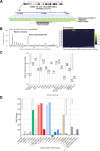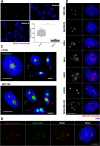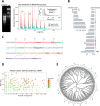Human Satellite 1A analysis provides evidence of pericentromeric transcription
- PMID: 36755311
- PMCID: PMC9909926
- DOI: 10.1186/s12915-023-01521-5
Human Satellite 1A analysis provides evidence of pericentromeric transcription
Abstract
Background: Pericentromeric regions of human chromosomes are composed of tandem-repeated and highly organized sequences named satellite DNAs. Human classical satellite DNAs are classified into three families named HSat1, HSat2, and HSat3, which have historically posed a challenge for the assembly of the human reference genome where they are misrepresented due to their repetitive nature. Although being known for a long time as the most AT-rich fraction of the human genome, classical satellite HSat1A has been disregarded in genomic and transcriptional studies, falling behind other human satellites in terms of functional knowledge. Here, we aim to characterize and provide an understanding on the biological relevance of HSat1A.
Results: The path followed herein trails with HSat1A isolation and cloning, followed by in silico analysis. Monomer copy number and expression data was obtained in a wide variety of human cell lines, with greatly varying profiles in tumoral/non-tumoral samples. HSat1A was mapped in human chromosomes and applied in in situ transcriptional assays. Additionally, it was possible to observe the nuclear organization of HSat1A transcripts and further characterize them by 3' RACE-Seq. Size-varying polyadenylated HSat1A transcripts were detected, which possibly accounts for the intricate regulation of alternative polyadenylation.
Conclusion: As far as we know, this work pioneers HSat1A transcription studies. With the emergence of new human genome assemblies, acrocentric pericentromeres are becoming relevant characters in disease and other biological contexts. HSat1A sequences and associated noncoding RNAs will most certainly prove significant in the future of HSat research.
Keywords: HSat1A; Noncoding RNA; Pericentromere; Satellite transcription; Transcript polyadenylation.
© 2023. The Author(s).
Conflict of interest statement
The authors declare that they have no competing interests .
Figures




Similar articles
-
Satellite RNAs: emerging players in subnuclear architecture and gene regulation.EMBO J. 2023 Sep 18;42(18):e114331. doi: 10.15252/embj.2023114331. Epub 2023 Aug 1. EMBO J. 2023. PMID: 37526230 Free PMC article. Review.
-
A classical revival: Human satellite DNAs enter the genomics era.Semin Cell Dev Biol. 2022 Aug;128:2-14. doi: 10.1016/j.semcdb.2022.04.012. Epub 2022 Apr 27. Semin Cell Dev Biol. 2022. PMID: 35487859 Review.
-
Locus-specific differential expression of human satellite sequences in the nuclei of cancer cells and heat-shocked cells.Nucleus. 2024 Dec;15(1):2431239. doi: 10.1080/19491034.2024.2431239. Epub 2024 Dec 2. Nucleus. 2024. PMID: 39620275 Free PMC article.
-
Genomic characterization of large heterochromatic gaps in the human genome assembly.PLoS Comput Biol. 2014 May 15;10(5):e1003628. doi: 10.1371/journal.pcbi.1003628. eCollection 2014 May. PLoS Comput Biol. 2014. PMID: 24831296 Free PMC article.
-
Alpha satellite DNA biology: finding function in the recesses of the genome.Chromosome Res. 2018 Sep;26(3):115-138. doi: 10.1007/s10577-018-9582-3. Epub 2018 Jul 5. Chromosome Res. 2018. PMID: 29974361 Free PMC article. Review.
Cited by
-
Identification of chromatin-associated RNAs at human centromeres.bioRxiv [Preprint]. 2025 Jun 8:2025.06.05.658139. doi: 10.1101/2025.06.05.658139. bioRxiv. 2025. PMID: 40501620 Free PMC article. Preprint.
-
Modeling the Copy Number of HSATII Repeats in Human Pericentromere.Int J Mol Sci. 2025 May 15;26(10):4751. doi: 10.3390/ijms26104751. Int J Mol Sci. 2025. PMID: 40429892 Free PMC article.
-
Satellite DNAs-From Localized to Highly Dispersed Genome Components.Genes (Basel). 2023 Mar 17;14(3):742. doi: 10.3390/genes14030742. Genes (Basel). 2023. PMID: 36981013 Free PMC article. Review.
-
Systematic computational hunting for small RNAs derived from ncRNAs during dengue virus infection in endothelial HMEC-1 cells.Front Bioinform. 2024 Jan 31;4:1293412. doi: 10.3389/fbinf.2024.1293412. eCollection 2024. Front Bioinform. 2024. PMID: 38357577 Free PMC article.
-
Satellite RNAs: emerging players in subnuclear architecture and gene regulation.EMBO J. 2023 Sep 18;42(18):e114331. doi: 10.15252/embj.2023114331. Epub 2023 Aug 1. EMBO J. 2023. PMID: 37526230 Free PMC article. Review.
References
-
- Yunis JJ, Yasmineh WG. Heterochromatin, satellite DNA, and cell function. Science. 1971;174(4015):1200–1209. - PubMed
-
- Kit S. Equilibrium sedimentation in density gradients of DNA preparations from animal tissues. J Mol Biol. 1961;3(6):711–IN712. - PubMed
-
- Choo KA. The centromere, vol. 320. Oxford: Oxford University Press; 1997.
-
- Lee C, Wevrick R, Fisher RB, Ferguson-Smith MA, Lin CC. Human centromeric DNAs. Hum Genet. 1997;100(3–4):291–304. - PubMed
Publication types
MeSH terms
Substances
Grants and funding
LinkOut - more resources
Full Text Sources
Research Materials

